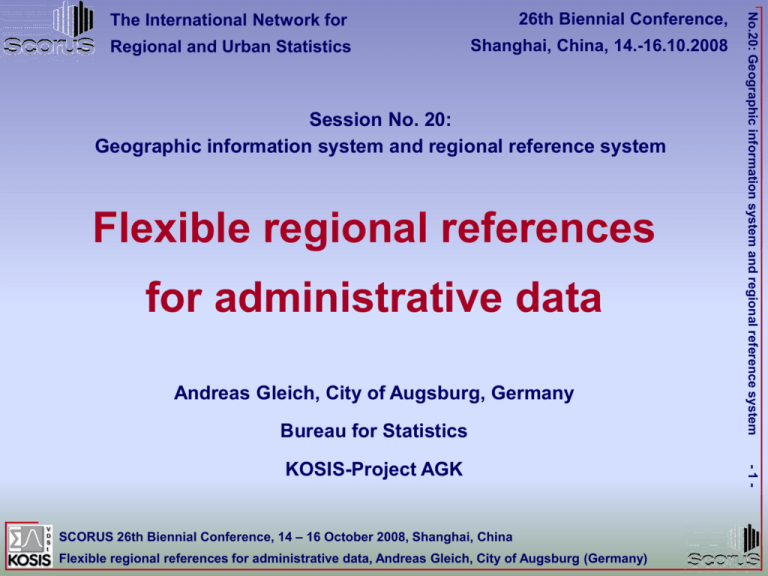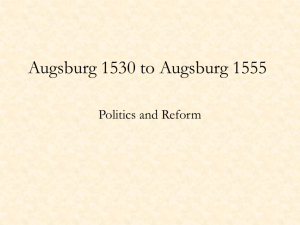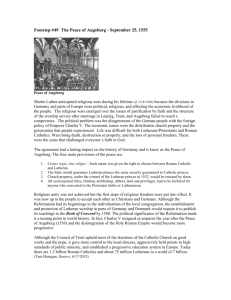PPT
advertisement

26th Biennial Conference, Regional and Urban Statistics Shanghai, China, 14.-16.10.2008 Session No. 20: Geographic information system and regional reference system Flexible regional references for administrative data Andreas Gleich, City of Augsburg, Germany Bureau for Statistics SCORUS 26th Biennial Conference, 14 – 16 October 2008, Shanghai, China Flexible regional references for administrative data, Andreas Gleich, City of Augsburg (Germany) -1- KOSIS-Project AGK No.20: Geographic information system and regional reference system The International Network for Local administrative date are becoming more important registers local registers (with the date of validity or date of recording and address) - population register, - statistical registers of buildings and dwellings, - register of motor vehicles, … federal registers (with the date validity at the time of excerpt and region) - employed and unemployed persons, - recipients of social benefits, … No.20: Geographic information system and regional reference system Main sources for statistical information sample surveys (with the reference date and address or statistical region) census (with the reference date and address or statistical region) frequently as a combination of register date and sample surveys -2- <= content data with time reference and regional reference SCORUS 26th Biennial Conference, 14 – 16 October 2008, Shanghai, China Flexible regional references for administrative data, Andreas Gleich, City of Augsburg (Germany) a) content reference survey, register and other administrative data (absolute / relative, qualitative / quantitative data) <= indicator, ratio, simulation, forecast b) regional reference c) time reference addresses (persons, locations) streets (addresses, borderline, type) regions (structure, administrative unit) geometry (spatial analyses, maps) dimension (distances, areas, proportions) <= collection, aggregation, visualisation <= content data and spatial references are changing in time! SCORUS 26th Biennial Conference, 14 – 16 October 2008, Shanghai, China Flexible regional references for administrative data, Andreas Gleich, City of Augsburg (Germany) -3- historical, actual or future date <= collecting, time series, forecasts No.20: Geographic information system and regional reference system => regional reference as a corner pillar in statistic Local planning needs local data Regional analyses refer to territorial structures. (administrative or planning units; e.g. zip code areas, school or election districts) Regional references of available content data usually differ from the geographical target structures of the analyses. (e.g. address references with zip code but not with school district - or future units) Territorial structures are changing in time. (e.g. new housing areas or a new school causes new school districts) Regional references of the content data need to be verified and „translated“ into the target structures of the analyses. (e.g. address into zip code, school district – or “old” content data to “new” units) (e.g. distance to school, accessibility of bus stops) -4- Typical questions to be answered: - localisation, distribution, densities (e.g. of students) - spatial clustering, dispersion (e.g. of handicapped, demand, traffic noise) - territorial accessibility, regional optimisation of supply and demand No.20: Geographic information system and regional reference system Typical problems using regional references <= in each case also changes over time are to be considered! SCORUS 26th Biennial Conference, 14 – 16 October 2008, Shanghai, China Flexible regional references for administrative data, Andreas Gleich, City of Augsburg (Germany) The 3 basic elements of the standard regional reference system: - streets (lookup table with keys and names of the streets) - postal addresses (street, house number and appendix) - sides of a block (section of a street). From structure to code SCORUS 26th Biennial Conference, 14 – 16 October 2008, Shanghai, China Flexible regional references for administrative data, Andreas Gleich, City of Augsburg (Germany) -5- Relations between these elements: - any street has 0-n addresses and is in 1-n sides of 1-n blocks - each address is associated to 1 street and is part of 1 side of 1 block - every side of a block belongs to 1 street with 0-n addresses No.20: Geographic information system and regional reference system Basic elements of the alphanumerical code It can be used to identify, associate and aggregate any statistical regions, like building blocks, sub-city district and administrative units, like constituencies, postal code areas, school districts … In combination with geometry any information can automatically be mapped or evaluated geographical information system (GIS). => Flexible regional reference system for actual and historical data! No.20: Geographic information system and regional reference system Additional elements of the regional reference system -6- SCORUS 26th Biennial Conference, 14 – 16 October 2008, Shanghai, China Flexible regional references for administrative data, Andreas Gleich, City of Augsburg (Germany) Addresses for referencing locations and collecting data (ca. 1% of the addresses of a city are changing in one year ca. 10 % of the inhabitants are moving in one year!) Stable territorial units in the system of building-blocks for collecting and to associate data (belong to the addresses) (<0.1% of the building-blocks are changing in one year) Flexible hierarchical system of the building-blocks to aggregate data (1-3 level above and 1-2 level below the block) (normally ~ 1 modification in one year!) Tessellation of the hierarchical elements to define new territorial units (regions) (normally <1 modification in one year, decentralized at the responsible authority) Linkage of these elements to geometry for visualisation & analyses SCORUS 26th Biennial Conference, 14 – 16 October 2008, Shanghai, China Flexible regional references for administrative data, Andreas Gleich, City of Augsburg (Germany) -7- Central maintenance system for these elements with the possibility of shared processing (multi-user system) No.20: Geographic information system and regional reference system => Elements of a flexible regional reference system Link between content data and geographical data (and tools) No.20: Geographic information system and regional reference system Tools for spatial and statistical analysis and presentation -8- => Managing requirements for geographical references Maintenance (postal addresses, territorial codes and geometry) References between different territorial structures Reference date or beginning and end of validity (time reference) for geographical references and content data Relationships of historical references, codes and geometries to actual references Validity checks: plausibility, consistency and integrity (in space & time) SCORUS 26th Biennial Conference, 14 – 16 October 2008, Shanghai, China Flexible regional references for administrative data, Andreas Gleich, City of Augsburg (Germany) The alphanumerical coding system based on a DBMS - to administrate the sub-city level structure of the city - to associate data - to aggregate the data to any statistical region. The geographical information system (GIS) - combines the alphanumeric with geometrical (vector) database - visualises themes as layers SCORUS 26th Biennial Conference, 14 – 16 October 2008, Shanghai, China Flexible regional references for administrative data, Andreas Gleich, City of Augsburg (Germany) -9- => modular application for - the basic functions - with consistent interrelations between the elements in space and time - in a relational DBMS No.20: Geographic information system and regional reference system => Instruments to administrate the regional references GIS Interface DBMS SCORUS 26th Biennial Conference, 14 – 16 October 2008, Shanghai, China Flexible regional references for administrative data, Andreas Gleich, City of Augsburg (Germany) - 10 - Graphical User Interface No.20: Geographic information system and regional reference system Structure of AGK – applications for maintaining the standardised geographical reference system Central management and hierarchical alphanumerical coding system: allocation of content data independent of origin for any record date and any site from the address to the side of the building block to a region: No.20: Geographic information system and regional reference system Standard geographical reference system AGK - 11 - SCORUS 26th Biennial Conference, 14 – 16 October 2008, Shanghai, China Flexible regional references for administrative data, Andreas Gleich, City of Augsburg (Germany) … with spatial integrity and consistency in time … dynamical interaction between code and geometry systems … for flexible code definitions from the address to the side of the building block to a region: No.20: Geographic information system and regional reference system … as a flexible, dynamic and consistence system - 12 - SCORUS 26th Biennial Conference, 14 – 16 October 2008, Shanghai, China Flexible regional references for administrative data, Andreas Gleich, City of Augsburg (Germany) Alphanumeric coding system with 3 basic elements - streets (lookup table with keys and names of the streets) - addresses (street, house number and appendix) - sides of a block (section of a street). Hierarchical code to identify, associate and aggregate - the sides of the building blocks to the building block - the building blocks to sub-city districts - and so on up to 1-3 hierarchical levels above the block - and any desired statistical region. - 13 - Covering the total area of the city based on the structure - a hierarchical code can be assigned to all data - any new address and the data which are related to it can be located in any sub-city level. No.20: Geographic information system and regional reference system Characteristics of regional reference on the sub-city level <= flexible regional reference system for actual and historical data SCORUS 26th Biennial Conference, 14 – 16 October 2008, Shanghai, China Flexible regional references for administrative data, Andreas Gleich, City of Augsburg (Germany) locations structure roads, rivers, topography alphanumeric code system identification and relation of streets, addresses and sides of a block, statistical regions geometry topological net with nodes, lines and polygons and attributes on it statistical data registers, surveys SCORUS 26th Biennial Conference, 14 – 16 October 2008, Shanghai, China Flexible regional references for administrative data, Andreas Gleich, City of Augsburg (Germany) - 14 - results tables, charts, maps representing the structure schools, polling stations No.20: Geographic information system and regional reference system Central position of the regional reference system No.20: Geographic information system and regional reference system Thank you for your Attention! - 15 - SCORUS 26th Biennial Conference, 14 – 16 October 2008, Shanghai, China Flexible regional references for administrative data, Andreas Gleich, City of Augsburg (Germany) Cooperation founded in 2001 for maintenance and development of more then 40 German municipalities in the KOSIS-Network for utilisation, implementation and maintenance of computer based instruments within the association of the German municipal statisticians (VDSt) Since 4 Years field-tested in cities - with 100 - 600 thousands inhabitants each (scalable to millions), altogether more than 7 millions - with different kinds of hierarchical structure - with or without geometry and also in regions with > 20 smaller cities <= standardized geographical reference system SCORUS 26th Biennial Conference, 14 – 16 October 2008, Shanghai, China Flexible regional references for administrative data, Andreas Gleich, City of Augsburg (Germany) - 16 - (based on recommendations of the Statistics Committee of the Union of German Municipalities of 1967, 1976 and 1991) No.20: Geographic information system and regional reference system KOSIS-Project AGK define, describe, manage, update and analyse the data of the streets, addresses, buildings, hierarchical structure and regions and its relationships and history WITH historical recording - new (incl. blocking, proposal , …) - processing (modifications, predecessor, termination) - re-assignment (of a terminated element, e.g. of an address) - split (e.g. street, building, BLS, …) - rename / move (e.g. name of a street, BLS, …) - join (e.g. name of a street, BLS, …) Operations: plausibility check, linkage in space and time, status, date SCORUS 26th Biennial Conference, 14 – 16 October 2008, Shanghai, China Flexible regional references for administrative data, Andreas Gleich, City of Augsburg (Germany) - 17 - WITHOUT historical recording - correction (e.g. typing errors, …) - deleting (e.g. incorrect datasets, …) No.20: Geographic information system and regional reference system Basic tasks and functions polygon city hierarchy (block and higher) street statistical region line side of a block node Relation 1:1 1:2 1:n n:m optionally address module KG Geometry buildings SCORUS 26th Biennial Conference, 14 – 16 October 2008, Shanghai, China Flexible regional references for administrative data, Andreas Gleich, City of Augsburg (Germany) - 18 - building ADZ No.20: Geographic information system and regional reference system Relations between the elements (simplified data model) Alphanumerical system Automation of the communication between the Interfaces e.g. interactive WWW-Application, … Description of the workflow for typical Questions Extension for integration of grid cells in the System Translation into foreign languages (on demand) Geometry Automation thematic cartography (content data interface) Integration of routing functionality Integration of external databases (WMS, Google, …) SCORUS 26th Biennial Conference, 14 – 16 October 2008, Shanghai, China Flexible regional references for administrative data, Andreas Gleich, City of Augsburg (Germany) - 19 - ... and international cooperation No.20: Geographic information system and regional reference system Perspectives ... The meaning of regional reference The basic elements of the sub-city references The instrument of German municipalities Demands Perspectives No.20: Geographic information system and regional reference system Content of the presentation - 20 - SCORUS 26th Biennial Conference, 14 – 16 October 2008, Shanghai, China Flexible regional references for administrative data, Andreas Gleich, City of Augsburg (Germany)




